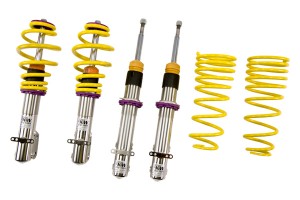Often referred to as ‘slamming to the ground’, adjusting the vehicle suspension is an essential element of improving the look of your car. By reducing the distance between the wheel and the wheel arches will not only achieve a racier image but if done correctly, can also produce a vehicle that gives its driver better road handling.
Manufacturers have a range of criteria to factor into the equation when setting the suspension height. They must consider external obstacles such as the dreaded speed ramp, curbs and potholes as well as internals such as road noise, driver position, road visibility and passenger accessibility, and not forgetting the overall desired imagery and market positioning within the car industry.
 If you are considering lowering the suspension you have two options depending on your desired outcome. If you are looking to increase the vehicles overall performance and not just its looks, then you really need to consider upgrading the existing suspension system. Here you are looking for a track performance set up, less comfortable on a leisurely Sunday drive but one which will get the most out of the vehicle round a race circuit.
If you are considering lowering the suspension you have two options depending on your desired outcome. If you are looking to increase the vehicles overall performance and not just its looks, then you really need to consider upgrading the existing suspension system. Here you are looking for a track performance set up, less comfortable on a leisurely Sunday drive but one which will get the most out of the vehicle round a race circuit.
However, be aware of car part brochures flogging generic suspension kits claiming to fit all models in a range. Do your homework. Consider engine weight, wheel size and overall weight these all have a bearing and will require different suspension characteristics. The result could necessitate more bodywork repair and you also run the risk of damage to the drive shaft and gearbox.
If you are looking to improve the car’s kerb appeal and possibly better road handling, then it is an option to simply fine tune the current system from its factory default soft suspension. But this tuning does not always equate to a simple standard adjustment to gain the optimum setting, it is very subjective and varies by each vehicle model and to some extent by the driver.
Obviously, if you have already beefed up the bodywork with extra kit then you won’t be able to go as low as without, otherwise when you meet your first speed ramp or curb stone you’ll no doubt pick up damage. You do have the option of fitting a grinding plate made from rubber or metal, this helps protect the front apron, and it’s more cost effective to replace this than a whole damaged skirt.
If you have made no other modifications then for the majority of road cars it is unwise to go any lower than 35mm, if the model is a hot hatch which by factory default already has an uprated system probably no lower than 30mm. Obviously if you have changed the wheels then this could be much lower.

